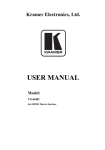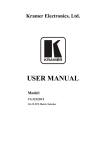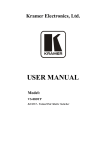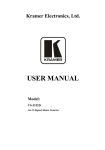Download USER MANUAL - Kramer Electronics
Transcript
K R A ME R E LE CT R O N IC S L TD .
USER MANUAL
MODEL:
VS-44HN
4x4 HDMI Matrix Switcher
P/N: 2900-300161 Rev 11
Contents
1
Introduction
1
2
2.1
2.2
2.3
3
3.1
3.2
3.3
4
Getting Started
Achieving the Best Performance
Safety Instructions
Recycling Kramer Products
Overview
About Fast Switching
Defining the VS-44HN 4x4 HDMI Matrix Switcher
Using the IR Transmitter
Installing in a Rack
2
2
2
3
4
5
6
8
9
5
Connecting the VS-44HN 4x4 HDMI Matrix Switcher
10
6
6.1
6.2
6.3
6.4
6.5
6.6
6.7
7
7.1
7.2
7.3
8
Operating the VS-44HN 4x4 HDMI Matrix Switcher
Switching an Input to an Output
Acquiring the EDID
Storing and Recalling a Switching Setting from a Preset
Changing the Port Switching Speed
Setting HDCP to On/Off
Resetting the IP Parameters
Switching Between Protocol 2000 and Protocol 3000
Connecting to the VS-44HN
Connecting to the VS-44HN 4x4 HDMI Matrix Switcher via RS-232
Connecting via Ethernet
Upgrading the Firmware
Technical Specifications
12
12
12
14
15
16
17
17
18
18
18
19
20
9
Default Communication Parameters
21
10
Default EDID
22
11
Kramer Protocol 2000
24
12
12.1
12.2
12.3
Protocol 3000
Kramer Protocol 3000 Syntax
Kramer Protocol 3000 Commands
Kramer Protocol 3000 – Detailed Commands
27
27
30
31
Figures
Figure 1: VS-44HN 4x4 HDMI Matrix Switcher Front Panel
Figure 2: VS-44HN 4x4 HDMI Matrix Switcher Rear Panel
Figure 3: Connecting the VS-44HN 4x4 HDMI Matrix Switcher
Figure 4: Store-Recall Button Configuration
6
7
10
14
VS-44HN - Contents
i
1
Introduction
Welcome to Kramer Electronics! Since 1981, Kramer Electronics has been
providing a world of unique, creative, and affordable solutions to the vast range of
problems that confront video, audio, presentation, and broadcasting professionals
on a daily basis. In recent years, we have redesigned and upgraded most of our
line, making the best even better!
Our 1,000-plus different models now appear in 14 groups that are clearly defined
by function: GROUP 1: Distribution Amplifiers; GROUP 2: Switchers and Routers;
GROUP 3: Control Systems; GROUP 4: Format/Standards Converters; GROUP 5:
Range Extenders and Repeaters; GROUP 6: Specialty AV Products; GROUP 7:
Scan Converters and Scalers; GROUP 8: Cables and Connectors; GROUP 9:
Room Connectivity; GROUP 10: Accessories and Rack Adapters; GROUP 11:
Sierra Video Products; GROUP 12: Digital Signage; GROUP 13: Audio; and
GROUP 14: Collaboration.
Congratulations on purchasing your Kramer VS-44HN 4x4 HDMI Matrix Switcher,
which is ideal for the following typical applications:
Conference room presentations
Advertising applications
Rental and staging
VS-44HN - Introduction
1
2
Getting Started
We recommend that you:
Unpack the equipment carefully and save the original box and packaging
materials for possible future shipment
i
2.1
Review the contents of this user manual
Go to http://www.kramerelectronics.com/support/product_downloads.asp
to check for up-to-date user manuals, application programs, and to check
if firmware upgrades are available (where appropriate).
Achieving the Best Performance
To achieve the best performance:
Use only good quality connection cables (we recommend Kramer highperformance high-resolution cables) to avoid interference, deterioration in
signal quality due to poor matching, and elevated noise levels (often
associated with low quality cables)
Do not secure the cables in tight bundles or roll the slack into tight coils
Avoid interference from neighboring electrical appliances that may adversely
influence signal quality
!
2.2
This equipment is to be used only inside a building. It may only be
connected to other equipment that is installed inside a building.
Safety Instructions
!
2
Position your VS-44HN away from moisture, excessive sunlight and dust
Caution:
There are no operator serviceable parts inside the unit
Warning:
Use only the power cord that is supplied with the unit
Warning:
Do not open the unit. High voltages can cause
electrical shock! Servicing by qualified personnel only
Warning:
Disconnect the power and unplug the unit from the wall
before installing
VS-44HN - Getting Started
2.3
Recycling Kramer Products
The Waste Electrical and Electronic Equipment (WEEE) Directive 2002/96/EC
aims to reduce the amount of WEEE sent for disposal to landfill or incineration by
requiring it to be collected and recycled. To comply with the WEEE Directive,
Kramer Electronics has made arrangements with the European Advanced
Recycling Network (EARN) and will cover any costs of treatment, recycling and
recovery of waste Kramer Electronics branded equipment on arrival at the EARN
facility. For details of Kramer’s recycling arrangements in your particular country
go to our recycling pages at http://www.kramerelectronics.com/support/recycling/.
VS-44HN - Getting Started
3
3
Overview
The VS-44HN is a high quality 4x4 matrix switcher for HDMI signals. It reclocks
and equalizes the signals and can route any input to any or all outputs
simultaneously.
In particular, the VS-44HN features:
Up to 6.75Gbps data rate (2.25Gbps per graphics channel)
Suitable for resolutions up to UXGA and 1080p at 60Hz
Support for HDCP (High Definition Digital Content Protection)
HDMI Support – HDMI (3D, Deep Color, x.v.Color™, Lip Sync)
3D pass-through
Support for up to 7.1 multi-channel audio
I-EDIDPro™ Kramer Intelligent EDID Processing™ – Intelligent EDID
handling & processing algorithm ensures Plug and Play operation for HDMI
systems
Kramer reKlocking™ and Equalization Technology that rebuilds the digital
signal to travel longer distances
A lock button to prevent unwanted tampering with the buttons on the front
panel
Preset memory locations for quick access to common configurations
Support for Kramer Protocol 2000 and Protocol 3000
You can control the VS-44HN using the front panel buttons, or remotely via:
RS-232 serial commands transmitted by a PC, touch screen system or other
serial controller
4
The Kramer infrared remote control transmitter
A PC connected to the Ethernet port on the device via a LAN
An external remote IR receiver (optional), see Section 3.3
VS-44HN - Overview
3.1
About Fast Switching
Older display devices required a longer time between the loss of one digital signal
and the introduction of another, as well as a physical disconnection of the
interconnecting cable in order to be able to detect and adjust to the new video
attributes and parameters. Normal switching, therefore, introduced a 5V signal
disconnection along with a delay in switching. Many newer display devices,
however, are now capable of “on-the-fly” switching.
Depending on the display device in use, the VS-44HN allows for fast switching
(minor reset and the connection kept alive) and extra fast switching (no reset and
the connection kept alive). Using the fast and extra fast switching modes allows for
fraction-of-a-second switching times when using high performance display devices
or when using a scaler on the video output.
VS-44HN - Overview
5
3.2
Defining the VS-44HN 4x4 HDMI Matrix Switcher
6
Figure 1: VS-44HN 4x4 HDMI Matrix Switcher Front Panel
1
#
Feature
IR Receiver and Indication LED
2
3
POWER Illuminated Power Switch
ALL Button
4
OFF Button
Function
Signal receiver for the infrared remote control transmitter. LED lights yellow when receiving
an IR signal
Turn the device on and off
Press followed by an input button to connect the selected input to all outputs
For example, press ALL and then Input button # 2 to connect input # 2 to all the outputs
5
6
VS-44HN – Overview
6
IN (1 to 4)
SELECT Buttons
OUT (1 to 4)
7
8
9
STO Button
RCL Button
LOCK Button
10
11
EDID Button
OUTPUT/INPUT 7-segment LED Display
Press after pressing an output button to disconnect the selected output from the inputs.
To disconnect all the outputs, press ALL followed by OFF
Press to select the input to switch after selecting an output (also used for storing machine
setups (see Section 6.3)
Press to select an output to switch followed by an input (also used for storing machine
setups (see Section 6.3)
Press to store the current switching setting to a preset (see Section 6.3)
Press to recall the switch setting from a preset (see Section 6.3)
Press and hold to toggle the locking/release of the front panel buttons.
When storing or recalling presets, press to store or recall the preset (see Section 6.3)
Press to capture the EDID (see Section 6.1)
Displays the input currently switched to the output which is marked above each input
VS-44HN - Overview
VS-44HN – Overview
Figure 2: VS-44HN 4x4 HDMI Matrix Switcher Rear Panel
#
12
13
14
15
16
Feature
IN HDMI Connectors (1 to 4)
OUT HDMI Connectors (1 to 4)
RS-232 9-pin D-sub Serial Port Connector
ETHERNET RJ-45 Connector
RESET Button
17
REMOTE IR Opening
Function
Connect to up to 4 HDMI sources
Connect to up to 4 HDMI acceptors
Connect to a PC/serial controller
Connect to a PC via a LAN
Press and hold while powering on the device to reset to factory default IP settings (see
Section 6.6 and Section 9)
Connect to an external IR receiver for controlling the device via and IR remote
controller (see Section 3.3)
Covered by a cap. The 3.5mm jack at the end of the internal IR connection cable fits into this
opening
18
Mains Power Connector and Fuse
7
VS-44HN - Overview
Plug in the power cord
7
3.3
Using the IR Transmitter
You can use the RC-IR3 IR transmitter to control the machine via the built-in IR
receiver on the front panel or, instead, via an optional external IR receiver (Model:
C-A35M/IRR-50). The external IR receiver can be located up to 15 meters away
from the machine. This distance can be extended to up to 60 meters when used
with three extension cables (Model: C-A35M/A35F-50).
Before using the external IR receiver, be sure to arrange for your Kramer dealer to
insert the internal IR connection cable (for example, P/N: 505-70434010-S) with
the 3.5mm connector that fits into the REMOTE IR opening on the rear panel.
Connect the external IR receiver to the REMOTE IR 3.5mm connector.
8
VS-44HN - Overview
4
Installing in a Rack
This section provides instructions for rack mounting the unit.
VS-44HN - Installing in a Rack
9
5
Connecting the VS-44HN 4x4 HDMI Matrix
Switcher
i
Always switch off the power to each device before connecting it to your
VS-44HN. After connecting your VS-44HN, connect its power and then
switch on the power to each device.
Figure 3: Connecting the VS-44HN 4x4 HDMI Matrix Switcher
10
VS-44HN - Connecting the VS-44HN 4x4 HDMI Matrix Switcher
To connect the VS-44HN 4x4 HDMI Matrix Switcher as illustrated in the
example in Figure 3:
1. Connect up to four HDMI sources (for example, DVD players) to the IN
HDMI connectors.
You do not have to connect all the sources.
2. Connect the four OUT HDMI connectors to up to four HDMI acceptors (for
example, LCD displays with built-in speakers).
You do not have to connect all the outputs.
3. If required, connect a PC/controller to the RS-232 port (see Section 7.1)
and/or the Ethernet port (see Section 7.2).
4. Connect the device to the mains electricity (not shown in Figure 3).
5. Power on the device.
6. If necessary, acquire the EDID (see Section 6.2).
VS-44HN - Connecting the VS-44HN 4x4 HDMI Matrix Switcher
11
6
Operating the VS-44HN 4x4 HDMI Matrix
Switcher
This section describes:
6.1
Switching an input to an output (see Section 6.1)
Acquiring the EDID (see Section 6.2)
Storing and recalling switch settings (see Section 6.3)
Changing the port switching speed (see Section 6.4)
Setting HDCP on or off (see Section 6.5)
Resetting the VS-44HN IP parameters (see Section 6.6)
Switching Between Protocol 2000 and Protocol 3000 (see Section 6.7)
Switching an Input to an Output
To switch an input to an output:
Press an output button followed by an input button to switch the selected
input to the selected output
6.2
Acquiring the EDID
You can acquire the EDID from any of the following:
One output set to one or more of the four inputs (see Section 6.2.1)
Different outputs set to different inputs (see Section 6.2.2)
The default EDID (see Section 6.2.3)
Note: Attempting to acquire the EDID from an output that does not have a display
device connected to it results in the default EDID being acquired.
12
VS-44HN - Operating the VS-44HN 4x4 HDMI Matrix Switcher
6.2.1
Acquiring the EDID from One Output
Note: You can assign the EDID from one output to any or all of the four inputs.
To acquire the EDID from a display device connected to one of the outputs:
1. Press the EDID and STO buttons simultaneously and hold them for 3
seconds.
Both buttons flash.
2. Press the input button to which the EDID is copied.
The selected input number flashes on the display.
3. Select the output from which the EDID is to be acquired.
4. Press the EDID button.
The EDID is stored when the display returns to normal and the EDID and
STO buttons stop flashing.
6.2.2
Acquiring the EDID from Different Outputs to Different Inputs
To acquire the EDID from several outputs (for example, OUT 1 to IN 1 and
OUT 4 to IN 3):
1. Connect the display devices to the outputs from which you want to acquire
the EDIDs.
2. Press the EDID and STO buttons simultaneously and hold them for 3
seconds.
Both buttons flash.
3. Press the input button to which the EDID is copied (for example, IN 1).
The selected input number flashes on the display.
4. Select the output from which the EDID is acquired (for example, OUT 1).
5. Press the IN 1 button.
The IN 1 button stops flashing.
6. Press the next input button to which the EDID is copied (for example, IN 3).
The selected input number flashes on the display.
VS-44HN - Operating the VS-44HN 4x4 HDMI Matrix Switcher
13
7. Select the output from which the EDID is acquired (for example, OUT 4).
8. Press the IN 3 button.
The IN 3 button stops flashing.
9. Press the input buttons to which you want to copy the EDID (for example, IN
1 and IN 3).
10. Make sure that the relevant input numbers flash on the display.
11. Press the EDID button.
The process is complete when the display returns to normal.
6.2.3
Acquiring the Default EDID
To store the default EDID on a selected input (for example, Input 2):
1. Press the EDID and STO buttons simultaneously and hold them for 3
seconds.
Both buttons flash.
2. Press the input (for example, Input 2) to which the EDID is to be copied.
The selected input number flashes on the display.
3. Press the OFF button until "0" (zero) appears on the display.
4. Press the EDID button.
The default EDID is stored on the selected input when the display returns to
normal.
6.3
Storing and Recalling a Switching Setting from a Preset
You can use the STO and RCL buttons to store up to 8 setups and then recall
them using the OUT (1-4) and IN (5-8) selector buttons (see Figure 4).
Figure 4: Store-Recall Button Configuration
14
VS-44HN - Operating the VS-44HN 4x4 HDMI Matrix Switcher
To store a switching setting (for example, to preset 8):
1. Configure the switching as required for the preset.
2. Press the STO button.
The STO button flashes.
3. Select an OUT or IN SELECT button to store the device setting (for example,
IN 4 for preset 8).
4. Press the STO button to store the current setup.
You have to press the STO button within 10 seconds or the procedure automatically
times out.
To recall a switching setting (for example, from preset 3):
1. Press the RCL button.
The RCL button flashes.
2. Press the relevant OUT or IN button that stored the preset (for example,
OUT 3/preset 3).
3. Press the RCL button to recall the stored preset.
The RCL button stops flashing.
6.4
Changing the Port Switching Speed
The switching speed can be set per port to any of the following:
3—Normal (default)
2—Fast
1—Extra fast
To change the port switching speed:
1. Ensure that the device is in normal switching mode, (that is, not Store, Recall
or EDID mode).
VS-44HN - Operating the VS-44HN 4x4 HDMI Matrix Switcher
15
2. Press the RCL and EDID buttons at the same time.
The RCL and EDID buttons flash, and the display indicates the switching
speed mode of each port.
IN 1, IN 2 and IN 3 are illuminated (red).
3. Press one or more (or ALL) of the OUT buttons to select the port to change.
The selected port setting on the LED display flashes.
4. Press one of the IN 1/IN 2/IN 3 button to toggle the switching speed, (to Extra
fast/Fast/Normal, respectively).
The switching speed displayed changes for the selected ports.
5. Press the LOCK button to confirm the change.
The switching speed for the selected port is changed and the device reverts
to the normal switching mode.
Note: If the LOCK button is not pressed within about 12 seconds, the device exits
the port speed switching mode automatically and all changes are lost.
6.5
Setting HDCP to On/Off
HDCP support can be enabled (On) or disabled (Off) for each of the HDMI inputs,
allowing the source to transmit a non-HDCP signal if required (for example, when
working with a Mac computer)
To set the HDCP:
1. Turn the power off on the machine.
2. Press and hold the IN 1, IN 2 and LOCK buttons simultaneously and turn the
power on while pressing these buttons (you will need more than one person
to perform this step).
The machine is set to the HDCP enable/disable mode.
The input front panel buttons’ status indicates the HDCP state of each input:
16
HDCP enabled (ON) on an input – that input button is illuminated
HDCP disabled (OFF) on an input – that button is not illuminated
VS-44HN - Operating the VS-44HN 4x4 HDMI Matrix Switcher
3. Press an input button to change its status.
You can press one or more inputs.
4. Once you have changed the status of HDCP on the inputs as desired, press
the EDID to save the changes and exit the HDCP enable/disable mode to
return to normal operation.
Note: If the EDID button is not pressed within about 12 seconds, the device exits
the port HDCP On/Off mode automatically and all changes are lost.
6.6
Resetting the IP Parameters
i
This procedure resets only the IP related parameters. All switching and
preset values remain unchanged.
To reset the IP parameters to their default values (see Section 9):
Press and hold the RESET button on the rear panel while powering up the
device
6.7
Switching Between Protocol 2000 and Protocol 3000
To switch from Protocol 2000 to Protocol 3000 and back again using the
front panel buttons:
1. On the TO OUTPUT 1 row, press Output buttons 1 and 3 at the same time.
Protocol 3000 is active.
2. On the TO OUTPUT 1 row, press Output buttons 1 and 2 at the same time.
Protocol 2000 is active.
i
Note that when sending consecutive protocol commands make sure to
maintain at least a 200ms delay between commands.
After performing EDID get/store commands, a 1 sec delay is required
before sending another protocol command.
VS-44HN - Operating the VS-44HN 4x4 HDMI Matrix Switcher
17
7
Connecting to the VS-44HN
This section describes:
7.1
Connecting to the VS-44HN via RS-232 (see Section 7.1)
Connecting to the VS-44HN via Ethernet (see Section 7.2)
Upgrading the firmware (see Section 7.3)
Connecting to the VS-44HN 4x4 HDMI Matrix Switcher
via RS-232
You can connect to the VS-44HN via an RS-232 connection using, for example, a
PC. Note that a null-modem adapter/connection is not required.
To connect to the VS-44HN via RS-232:
Connect the RS-232 9-pin D-sub rear panel port on the VS-44HN unit via a
9-wire straight cable (only pin 2 to pin 2, pin 3 to pin 3, and pin 5 to pin 5
need to be connected) to the RS-232 9-pin D-sub port on your PC
7.2
Connecting via Ethernet
You can connect to the VS-44HN via Ethernet using either of the following
methods:
Directly to the PC using a crossover cable (see Section 7.2.1)
Via a network hub, switch, or router, using a straight-through cable (see
Section 7.2.2)
After connecting the VS-44HN to the Ethernet port, configure your local Ethernet port
by following the instructions in the Ethernet Configuration (K-LanConfigurator) guide
available from http://www.kramerelectronics.com/support/product_downloads.asp
or from the Downloads section of the VS-44HN Web page.
Note: If you want to connect via a router and your IT system is based on IPv6,
speak to your IT department for specific installation instructions.
18
VS-44HN - Connecting to the VS-44HN
7.2.1
Connecting the Ethernet Port Directly to a PC
You can connect the Ethernet port of the VS-44HN directly to the Ethernet port on
your PC using a crossover cable with RJ-45 connectors.
i
7.2.2
This type of connection is recommended for identifying the VS-44HN
with the factory configured default IP address.
Connecting the Ethernet Port via a Network Hub or Switch
You can connect the Ethernet port of the VS-44HN to the Ethernet port on a
network hub or using a straight-through cable with RJ-45 connectors.
7.3
Upgrading the Firmware
For instructions on upgrading the firmware see “Upgrading the VS-44HN Firmware
Using the STC Software”.
VS-44HN - Connecting to the VS-44HN
19
8
Technical Specifications
INPUTS:
4 HDMI Connectors
OUTPUTS:
4 HDMI Connectors
BANDWIDTH:
Up to 6.75Gbps data rate (2.25Gbps per graphic
channel)
COMPLIANCE WITH HDMI
STANDARD:
HDMI and HDCP
RESOLUTION:
Up to UXGA; 1080p
POWER CONSUMPTION:
100240V AC, 50/60Hz, 25VA
CONTROLS:
Front panel buttons, infrared remote control transmitter,
RS-232, Ethernet
OPERATING TEMPERATURE:
0° to +40°C (32° to 104°F)
STORAGE TEMPERATURE:
-40° to +70°C (-40° to 158°F)
HUMIDITY:
10% to 90%, RHL non-condensing
DIMENSIONS:
19” x 7.24” x 1U (W, D, H)
WEIGHT:
1.6kg (3.5lbs) approx.
INCLUDED ACCESSORIES:
Power cord, IR transmitter, rack ”ears”
OPTIONS:
External remote IR receiver cable
Specifications are subject to change without notice at http://www.kramerelectronics.com
20
VS-44HN - Technical Specifications
9
Default Communication Parameters
RS-232
Protocol 2000 (Default)
Protocol 3000
Baud Rate
9600
Baud Rate
9600
Data Bits
8
Data Bits
8
Stop Bits
1
Stop Bits
1
Parity
None
Parity
None
Command Format
HEX
Command Format
ASCII
Example (Output
1 to Input 1)
0x01, 0x81, 0x81, 0x81
Example (Output 1 to
Input 1)
#VID1>1<CR>
Switching Protocol
P2000 –> P3000
P3000 –> P2000
Command
0x38, 0x80, 0x83, 0x81
Command
#P2000<CR>
Front Panel
Press and hold Output 1 and
Output 3 simultaneously
Front Panel
Press and hold Output 1
and Output 2 simultaneously
Ethernet
IP Address
192.168.1.39
TCP Port
5000
Subnet Mask
255.255.255.0
UDP Port
50000
VS-44HN - Default Communication Parameters
21
10
Default EDID
Monitor
Model name............... VS-44HN
Manufacturer............. KMR
Plug and Play ID......... KRM0200
Serial number............ 1
Manufacture date......... 2010, ISO week 24
Filter driver............ None
------------------------EDID revision............ 1.3
Input signal type........ Digital (DVI)
Color bit depth.......... Undefined
Display type............. RGB color
Screen size.............. 700 x 390 mm (31.5 in)
Power management......... Not supported
Extension blocs.......... 1 (CEA-EXT)
------------------------DDC/CI................... n/a
Color characteristics
Default color space...... Non-sRGB
Display gamma............ 2.20
Red chromaticity......... Rx 0.640 - Ry 0.341
Green chromaticity....... Gx 0.286 - Gy 0.610
Blue chromaticity........ Bx 0.146 - By 0.069
White point (default).... Wx 0.284 - Wy 0.293
Additional descriptors... None
Timing characteristics
Horizontal scan range.... 31-94kHz
Vertical scan range...... 50-85Hz
Video bandwidth.......... 170MHz
CVT standard............. Not supported
GTF standard............. Not supported
Additional descriptors... None
Preferred timing......... Yes
Native/preferred timing.. 1280x720p at 60Hz
Modeline............... "1280x720" 74.250 1280 1390 1430 1650 720 725 730 746 +hsync -vsync
Detailed timing #1....... 1920x1080p at 60Hz (16:9)
Modeline............... "1920x1080" 148.500 1920 2008 2052 2200 1080 1084 1089 1125 +hsync +vsync
Standard timings supported
720 x 400p at 70Hz - IBM VGA
720 x 400p at 88Hz - IBM XGA2
640 x 480p at 60Hz - IBM VGA
640 x 480p at 67Hz - Apple Mac II
640 x 480p at 72Hz - VESA
640 x 480p at 75Hz - VESA
800 x 600p at 56Hz - VESA
800 x 600p at 60Hz - VESA
800 x 600p at 72Hz - VESA
800 x 600p at 75Hz - VESA
832 x 624p at 75Hz - Apple Mac II
1024 x 768i at 87Hz - IBM
1024 x 768p at 60Hz - VESA
1024 x 768p at 70Hz - VESA
1024 x 768p at 75Hz - VESA
1280 x 1024p at 75Hz - VESA
1152 x 870p at 75Hz - Apple Mac II
1280 x 720p at 60Hz - VESA STD
1280 x 800p at 60Hz - VESA STD
1440 x 900p at 60Hz - VESA STD
1280 x 960p at 60Hz - VESA STD
1280 x 1024p at 60Hz - VESA STD
1400 x 1050p at 60Hz - VESA STD
1680 x 1050p at 60Hz - VESA STD
1600 x 1200p at 60Hz - VESA STD
EIA/CEA-861 Information
Revision number.......... 3
IT underscan............. Not supported
Basic audio.............. Supported
YCbCr 4:4:4.............. Supported
YCbCr 4:2:2.............. Supported
Native formats........... 1
22
VS-44HN - Default EDID
Detailed timing #1....... 720x480p at 60Hz (4:3)
Modeline............... "720x480" 27.000 720 736 798 858 480 489 495 525 -hsync -vsync
Detailed timing #2....... 1920x1080i at 60Hz (16:9)
Modeline............... "1920x1080" 74.250 1920 2008 2052 2200 1080 1084 1094 1124 interlace +hsync +vsync
Detailed timing #3....... 1920x1080i at 50Hz (16:9)
Modeline............... "1920x1080" 74.250 1920 2448 2492 2640 1080 1084 1094 1124 interlace +hsync +vsync
Detailed timing #4....... 1280x720p at 60Hz (16:9)
Modeline............... "1280x720" 74.250 1280 1390 1430 1650 720 725 730 750 +hsync +vsync
Detailed timing #5....... 1280x720p at 50Hz (16:9)
Modeline............... "1280x720" 74.250 1280 1720 1760 1980 720 725 730 750 +hsync +vsync
CE video identifiers (VICs) - timing/formats supported
720 x 576p at 50Hz - EDTV (4:3, 16:15)
1280 x 720p at 50Hz - HDTV (16:9, 1:1)
1920 x 1080i at 60Hz - HDTV (16:9, 1:1)
1920 x 1080i at 50Hz - HDTV (16:9, 1:1)
1280 x 720p at 60Hz - HDTV (16:9, 1:1) [Native]
1920 x 1080p at 60Hz - HDTV (16:9, 1:1)
1920 x 1080p at 50Hz - HDTV (16:9, 1:1)
NB: NTSC refresh rate = (Hz*1000)/1001
CE audio data (formats supported)
LPCM 3-channel, 24-bits
at 44/48 kHz
CE speaker allocation data
Channel configuration.... 7.1
Front left/right......... Yes
Front LFE................ No
Front center............. Yes
Rear left/right.......... No
Rear center.............. No
Front left/right center.. No
Rear left/right center... No
Rear LFE................. No
CE vendor specific data (VSDB)
IEEE registration number. 0x000C03
CEC physical address..... 1.0.0.0
Maximum TMDS clock....... 165MHz
Report information
Date generated........... 08-Jul-12
Software revision........ 2.60.0.972
Data source.............. File
Operating system......... 5.1.2600.2.Service Pack 3
Raw data
00,FF,FF,FF,FF,FF,FF,00,2E,4D,00,02,01,00,00,00,18,14,01,03,81,46,27,78,0A,D5,7C,A3,57,49,9C,25,
11,48,4B,FF,FF,80,81,C0,81,00,95,00,81,40,81,80,90,40,B3,00,A9,40,01,1D,00,72,51,D0,1A,20,6E,28,
55,00,7E,88,42,00,00,1A,02,3A,80,18,71,38,2D,40,58,2C,45,00,C4,8E,21,00,00,1E,00,00,00,FC,00,56,
53,2D,34,32,48,4E,0A,20,20,00,00,00,00,00,00,FD,00,32,55,1F,5E,11,00,0A,20,20,20,20,20,20,01,7B,
02,03,1A,71,47,11,13,05,14,84,10,1F,23,0A,06,04,83,05,00,00,65,03,0C,00,10,00,8C,0A,D0,8A,20,E0,
2D,10,10,3E,96,00,58,C2,21,00,00,18,01,1D,80,18,71,1C,16,20,58,2C,25,00,C4,8E,21,00,00,9E,01,1D,
80,D0,72,1C,16,20,10,2C,25,80,C4,8E,21,00,00,9E,01,1D,00,72,51,D0,1E,20,6E,28,55,00,C4,8E,21,00,
00,1E,01,1D,00,BC,52,D0,1E,20,B8,28,55,40,C4,8E,21,00,00,1E,00,00,00,00,00,00,00,00,00,00,00,90
VS-44HN - Default EDID
23
11
Kramer Protocol 2000
The Kramer Protocol 2000 RS-232/RS-485 communication uses four bytes of
information as defined below. All the values in the table are decimal, unless
otherwise stated.
MSB
LSB
DESTINATION
INSTRUCTION
0
D
N5
N4
N3
N2
N1
N0
7
1st byte
6
5
4
3
2
1
0
INPUT
I6
6
I5
5
I4
4
I3
3
I2
2
I1
1
I0
0
OUTPUT
O6
6
O5
5
O4
4
O3
3
O2
2
O1
1
O0
0
OVR
6
X
5
MACHINE NUMBER
M4
M3
4
3
M2
2
M1
1
M0
0
1
7
2nd byte
1
7
3rd byte
1
7
4th byte
1st BYTE:
Bit 7 – Defined as 0.
D – “DESTINATION”:
0 - for sending information to the switchers (from the PC);
1 - for sending to the PC (from the switcher).
N5…N0 – “INSTRUCTION”
The function that is to be performed by the switcher(s) is defined by the INSTRUCTION (6 bits). Similarly, if a function is
performed via the machine’s keyboard, then these bits are set with the INSTRUCTION NO., which was performed. The
instruction codes are defined according to the table below (INSTRUCTION NO. is the value to be set for N5…N0).
Bit 7 – Defined as 1.
I6…I0 – “INPUT”.
When switching (ie. instruction codes 1 and 2), the INPUT (7 bits) is set as the input number which is to be switched.
Similarly, if switching is done via the machine’s front-panel, then these bits are set with the INPUT NUMBER which was
switched. For other operations, these bits are defined according to the table.
2nd BYTE:
Bit 7 – Defined as 1.
O6…O0 – “OUTPUT”.
When switching (ie. instruction codes 1 and 2), the OUTPUT (7 bits) is set as the output number which is to be switched.
Similarly, if switching is done via the machine’s front-panel, then these bits are set with the OUTPUT NUMBER which
was switched. For other operations, these bits are defined according to the table.
3rd BYTE:
Bit 7 – Defined as 1.
Bit 5 – Don’t care.
OVR – Machine number override.
M4…M0 – MACHINE NUMBER.
Used to address machines in a system via their machine numbers. When several machines are controlled from a single
serial port, they are usually configured together with each machine having an individual machine number. If the OVR bit
is set, then all machine numbers accept (implement) the command, and the addressed machine replies. For a single
machine controlled via the serial port, always set M4…M0 = 1, and make sure that the machine itself is configured as
MACHINE NUMBER = 1.
4th BYTE:
24
VS-44HN - Kramer Protocol 2000
Instruction Codes for Protocol 2000
Instruction
Definition for Specific Instruction
#
Input
Description
0
1
RESET VIDEO
SWITCH VIDEO
3
STORE VIDEO
STATUS
RECALL VIDEO
STATUS
REQUEST STATUS
OF A VIDEO OUTPUT
REQUEST WHETHER
SETUP IS DEFINED /
VALID INPUT IS
DETECTED
LOCK FRONT PANEL
4
5
15
30
31
56
61
62
0
Set equal to video input which is
to be switched
(0 = disconnect)
Set as SETUP #
0
Set equal to video output which is
to be switched
(0 = to all the outputs)
0 - to store
1 - to delete
0
1
2, 15
Equal to output number whose
status is reqd
0 - for checking if setup is defined
1 - for checking if input is valid
4, 3
0 - Panel unlocked
1 - Panel locked
0
0
2
0
16
0
1 - video machine name
2 - audio machine name
3 - video software version
4 - audio software version
5 - RS422 controller name
6 - RS422 controller version
7 - remote control name
8 - remote software version
9 - Protocol 2000 revision
DEFINE MACHINE
Kramer protocol 3000
0 - Request first 4 digits
1 - Request first suffix
2 - Request second suffix
3 - Request third suffix
10 - Request first prefix
11 - Request second prefix
12 - Request third prefix
19
1 - number of inputs
2 - number of outputs
3 - number of setups
1 - for video
2 - for audio
3 - for SDI
4 - for
remote
panel
5 - for RS422
controller
Set as SETUP #
Set as SETUP #
SETUP #
or
Input #
REQUEST WHETHER
PANEL IS LOCKED
CHANGE TO ASCII
IDENTIFY
MACHINE
62
Notes
Output
2, 3, 15
2, 3, 15
8
13
NOTES on the above table:
NOTE 1 - When the master switcher is reset, (e.g. when it is turned on), the reset code is sent to the PC. If this code is
sent to the switchers, it resets according to the present power-down settings.
NOTE 2 - These are bi-directional definitions. That is, if the switcher receives the code, it performs the instruction; and if
the instruction is performed (due to a keystroke operation on the front panel), then these codes are sent. For example, if
the HEX code
01
85
88
83
was sent from the PC, then the switcher (machine 3) switches input 5 to output 8. If the user switched input 1 to output 7
via the front panel keypad, then the switcher sends HEX codes:
41
81
87
83
to the PC.
When the PC sends one of the commands in this group to the switcher, then, if the instruction is valid, the switcher
replies by sending to the PC the same four bytes that it was sent (except for the first byte, where the DESTINATION bit
is set high).
NOTE 3 - SETUP # 0 is the present setting. SETUP # 1 and higher are the settings saved in the switcher's memory, (i.e.
those used for Store and Recall).
NOTE 4 - The reply to a "REQUEST" instruction is as follows: the same instruction and INPUT codes as were sent are
returned, and the OUTPUT is assigned the value of the requested parameter. The replies to instructions 10 and 11 are
as per the definitions in instructions 7 and 8 respectively. For example, if the present status of machine number 5 is
breakaway setting, then the reply to the HEX code
0B
80
would be HEX codes
4B
80
80
85
81
85
NOTE 8 - The reply is as in TYPE 3 above, except that here the OUTPUT is assigned with the value 0 if the setup is not
defined / no valid input is detected; or 1 if it is defined / valid input is detected.
VS-44HN - Kramer Protocol 2000
25
NOTE 13 - This is a request to identify the switcher/s in the system. If the OUTPUT is set as 0, and the INPUT is set as
1, 2, 5 or 7, the machine sends its name. The reply is the decimal value of the INPUT and OUTPUT. For example, for a
2216, the reply to the request to send the audio machine name would be (HEX codes):
7D
96
90
81 (i.e. 128dec+ 22dec for 2nd byte, and 128dec+ 16dec for 3rd byte).
If the request for identification is sent with the INPUT set as 3 or 4, the appropriate machine sends its software version
number. Again, the reply would be the decimal value of the INPUT and OUTPUT - the INPUT representing the number
in front of the decimal point, and the OUTPUT representing the number after it. For example, for version 3.5, the reply to
the request to send the version number would be (HEX codes):
7D
83
85
81 (i.e. 128dec+ 3dec for 2nd byte, 128dec+ 5dec for 3rd byte).
If the OUTPUT is set as 1, then the ASCII coding of the lettering following the machine’s name is sent. For example, for
the VS-7588YC, the reply to the request to send the first suffix would be (HEX codes):
7D
D9
C3
81 (i.e. 128dec+ ASCII for “Y”; 128dec+ ASCII for “C”).
NOTE 14 - The number of inputs and outputs refers to the specific machine which is being addressed, not to the system.
For example, if six 16X16 matrices are configured to make a 48X32 system (48 inputs, 32 outputs), the reply to the HEX
code
3E
82
81
82 (ie. request the number of outputs)
would be HEX codes
7E
82
90
82
ie. 16 outputs
NOTE 15 – When the OVR bit (4th byte) is set, then the “video” commands have universal meaning. For example,
instruction 1 (SWITCH VIDEO) causes all units (including audio, data, etc.) to switch. Similarly, if a machine is in
“FOLLOW” mode, it performs any “video” instruction.
NOTE 16 - The reply to the “REQUEST WHETHER PANEL IS LOCKED” is as in NOTE 4 above, except that here the
OUTPUT is assigned with the value 0 if the panel is unlocked, or 1 if it is locked.
NOTE 19 - After this instruction is sent, the unit will respond to the ASCII command set defined by the OUTPUT byte.
The ASCII command to operate with the HEX command set must be sent in order to return to working with HEX codes.
26
VS-44HN - Kramer Protocol 2000
12
Protocol 3000
By default, the VS-44HN is set to Protocol 2000 (see Section 11) but is also
compatible with Kramer’s protocol 3000.
i
Note that the VS-44HN needs to be set to protocol 2000 in order to
use the IR remote control.
The VS-44HN can be operated using serial commands from a PC, remote
controller or touch screen using the Kramer Protocol 3000.
This section describes:
Kramer Protocol 3000 syntax (see Section 12.1)
Kramer Protocol 3000 commands (see Section 12.2)
12.1
Kramer Protocol 3000 Syntax
12.1.1
Host Message Format
Start
Address (optional)
Body
Delimiter
#
device_id@
Message
CR
12.1.1.1
Simple Command
Command string with only one command without addressing:
Start
Body
Delimiter
#
Command SP Parameter_1,Parameter_2,…
CR
12.1.1.2
Command String
Formal syntax with commands concatenation and addressing:
12.1.2
Start
Address
Body
Delimiter
#
device_id@
Command_1 Parameter1_1,Parameter1_2,…|
Command_2 Parameter2_1,Parameter2_2,…|
Command_3 Parameter3_1,Parameter3_2,…|…
CR
Device Message Format
Start
Address (optional)
Body
delimiter
~
device_id@
Message
CR LF
VS-44HN - Protocol 3000
27
12.1.2.1
Device Long Response
Echoing command:
Start
Address (optional)
Body
Delimiter
~
device_id@
Command SP [Param1 ,Param2 …] result
CR LF
CR = Carriage return (ASCII 13 = 0x0D)
LF = Line feed (ASCII 10 = 0x0A)
SP = Space (ASCII 32 = 0x20)
12.1.3
Command Terms
Command
A sequence of ASCII letters ('A'-'Z', 'a'-'z' and '-').
Command and parameters must be separated by at least one space.
Parameters
A sequence of alphanumeric ASCII characters ('0'-'9','A'-'Z','a'-'z' and some special
characters for specific commands). Parameters are separated by commas.
Message string
Every command entered as part of a message string begins with a message
starting character and ends with a message closing character.
Note: A string can contain more than one command. Commands are separated by
a pipe ( '|' ) character.
Message starting character
'#' – For host command/query
'~' – For device response
Device ID (Optional, for K-NET)
K-NET Device ID followed by '@'
Query sign
'?' follows some commands to define a query request.
Message closing character
CR – For host messages; carriage return (ASCII 13)
CRLF – For device messages; carriage return (ASCII 13) + line-feed (ASCII 10)
28
VS-44HN - Protocol 3000
Command chain separator character
When a message string contains more than one command, a pipe ( '|' ) character
separates each command.
Spaces between parameters or command terms are ignored.
12.1.4
Entering Commands
You can directly enter all commands using a terminal with ASCII communications
software, such as HyperTerminal, Hercules, etc. Connect the terminal to the serial
or Ethernet port on the Kramer device. To enter CR press the Enter key.
( LF is also sent but is ignored by command parser).
For commands sent from some non-Kramer controllers like Crestron, some
characters require special coding (such as, /X##). Refer to the controller manual.
12.1.5
Command Forms
Some commands have short name syntax in addition to long name syntax to allow
faster typing. The response is always in long syntax.
12.1.6
Chaining Commands
Multiple commands can be chained in the same string. Each command is
delimited by a pipe character (“|”). When chaining commands, enter the message
starting character and the message closing character only once, at the
beginning of the string and at the end.
Commands in the string do not execute until the closing character is entered.
A separate response is sent for every command in the chain.
12.1.7
Maximum String Length
64 characters
VS-44HN - Protocol 3000
29
12.2
Kramer Protocol 3000 Commands
Short
Form
Command
Description
Permission
#
Protocol handshaking
End User
BUILDDATE?
Read device build date
End User
CPEDID
Copy EDID data from the output to the input
EEPROM
End User
DISPLAY?
Read if output is valid
End User
FACTORY
Reset to factory default configuration
GEDID
Read EDID data
User SW
Internal
GEDID-EXT
Read EDID data from external device
connected to output
User SW
Internal
HELP
List of commands
End User
IDV
Visual identify device
End User
INFO-IO?
Read in/out count
End User
INFO-PRST?
Read maximum preset count
End User
LOCK-FP
LCK
Lock front panel
Administrator
LOCK-FP?
LCK?
Read Lock front panel
End User
MODEL?
Read device model
End User
P2000
Switch to protocol 2000
End User
PROT-VER?
Read device protocol version
End User
PRST-LST?
Read saved presets list
End User
PRST-RCL
Recall saved preset
End User
PRST-STO
Store current connections to preset
End User
PRST-VID?
Read video connections from saved preset
End User
RESET
Reset device
Administrator
SIGNAL?
Read if input is valid
End User
SN?
Read device serial number
End User
VERSION?
Read device firmware version
End User
VID
Switch Video only
End User
VID?
Get Video switch state
End User
i
30
Note that the some of the following commands differ from the Kramer
standard protocol commands.
VS-44HN - Protocol 3000
12.3
Kramer Protocol 3000 – Detailed Commands
This section describes the detailed commands list.
Command - BUILD-DATE
Command Type - System-mandatory
Command Name
Permission
Transparency
Set:
-
-
-
Get:
BUILD-DATE?
End User
Public
Description
Syntax
Set:
Get device build date
#BUILD-DATE␍
Get:
-
-
Response
~nn@BUILD-DATE␠date␠time␍␊
Parameters
date - Format: YYYY/MM/DD where YYYY = Year, MM = Month, DD = Day
time - Format: hh:mm:ss where hh = hours, mm = minutes, ss = seconds
Command - CPEDID
Command Name
Command Type - System
Permission
Transparency
Set:
CPEDID
End User
Public
Get:
-
-
-
Description
Syntax
Set:
Copy EDID data from the output to
the input EEPROM
#CPEDID␠ output_id, input_id ␍
Get:
-
-
Response
~nn@CPEDID␠output_id, input_id ␍␊
Parameters
output_id – Video output id
input_id – Video input id
Response Triggers
Response is sent to the com port from which the Set was received (before execution)
Notes
Destination bitmap size depends on device properties (for 64 inputs it is a 64-bit word)
Example: bitmap 0x0013 means inputs 1,2 and 5 are loaded with the new EDID
VS-44HN - Protocol 3000
31
Command - DISPLAY?
Command Type - System
Command Name
Permission
Transparency
Set:
-
-
-
Get
DISPLAY?
End User
Public
Description
Syntax
Set:
-
-
Get:
Get output HPD status
#DISPLAY?␠out_id␍
Response
~ nn@DISPLAY ␠out_id,status ␍␊
Parameters
out_id - output number
status - HPD status according to signal validation – 0: Signal or sink is not valid, 1: Signal or sink is
valid
Response Triggers
After execution, response is sent to the com port from which the Get was received
Response is sent after every change in output HPD status ON to OFF
Response is sent after every change in output HPD status OFF to ON and ALL parameters (new EDID,
etc.) are stable and valid
Command – FACTORY
Command Name
Command Type – System-mandatory
Permission
Transparency
Set:
FACTORY
End User
-
Get:
-
-
-
Description
Syntax
Set:
Reset device to factory defaults configuration
#FACTORY␍
Get :
-
-
Response
~nn@FACTORY␠OK␍␊
Notes
This command deletes all user data from the device. The deletion can take some time.
32
VS-44HN - Protocol 3000
Command - GEDID
Command Name
Get:
GEDID
Command Type - System
Permission
Transparency
End User
Public
Description
Syntax
Get:
#GEDID␠eeprom_id ␍
Read EDID data
Response
Multi line response:
~nn@GEDID␠ eeprom_id,size␍␊
EDID_data␍␊
~nn@GEDID␠ eeprom_id ␠OK␍␊
Parameters
eeprom_id – EEPROM to get the EDID from
size – Device sends this parameter in response. Size of EDID that will print.
edid_data – EDID data as stream of bytes.
Response Triggers
Response is sent to the com port from which the Set (before execution) / Get command was received
Notes
For Get, size=0 means EDID is not supported
For old devices that do not support this command, ~nn@ ERR 002␍␊ is received
Command – GEDID-EXT
Command Name
Get:
GEDID-EXT
Description
Get:
Read EDID from external device
connected to output
Command Type - Common
Permission
Transparency
End User
Public
Syntax
#GEDID-EXT␠out_id ␍
Response
Multi line response:
~nn@GEDID-EXT␠ out_id,size␍␊
EDID_data␍␊
~nn@GEDID-EXT␠ out_id ␠OK␍␊
Parameters
out_id – EEPROM to get the EDID from
size – Device sends this parameter in response. Size of EDID that will print.
edid_data – EDID data as stream of bytes.
VS-44HN - Protocol 3000
33
Command - HELP
Command Name
Command Type - System-mandatory
Permission
Transparency
Set:
-
-
-
Get:
HELP
End User
Public
Description
Syntax
Set:
-
Get:
Get command list or help for specific
command
2 options:
1. #HELP␍
2. #HELP␠command_name␍
Response
1. Multi-line: ~nn@Device available protocol 3000 commands:␍␊command,␠command…␍␊
To get help for command use: HELP (COMMAND_NAME)␍␊
2. Multi-line: ~nn@HELP␠command:␍␊description␍␊USAGE:usage ␍␊
Command - IDV
Command Name
Command Type - System
Permission
Transparency
Set:
IDV
End User
Public
Get:
-
-
-
Description
Syntax
Set:
Set visual indication from device
#IDV␍
Get:
-
-
Response
~nn@IDV␠OK␍␊
Notes
Using this command, some devices can light a sequence of buttons or LEDs to allow identification of a
specific device from similar devices
Command - INFO-IO?
Command Name
Command Type - System
Permission
Transparency
Set:
-
-
-
Get:
INFO-IO?
End User
Public
Description
Syntax
Set:
-
-
Get:
Get in/out count
#INFO-IO?␍
Response
~nn@INFO-IO?␠IN␠ inputs_count, OUT␠outputs_count␍␊
Parameters
inputs_count - number of inputs in the unit
outputs_count - number of outputs in the unit
34
VS-44HN - Protocol 3000
Command - INFO-PRST?
Command Name
Command Type - System
Permission
Transparency
Set:
-
-
-
Get:
INFO-PRST?
End User
Public
Description
Syntax
Set:
-
-
Get:
Get maximum preset count
#INFO-PRST?␍
Response
~nn@INFO-PRST?␠VID␠preset_video_count, AUD␠preset_audio_count␍␊
Parameters
preset_video_count - maximum number of video presets in the unit
preset_audio_count - maximum number of audio presets in the unit
Notes
In most units, video and audio presets with the same number are stored and recalled together by
commands #PRST-STO and #PRST-RCL
VS-44HN - Protocol 3000
35
Command - LDEDID
Command Name
Command Type - System
Permission
Transparency
Set:
LDEDID
End User
Public
Get:
-
-
-
Description
Syntax
Set:
Write EDID data from external
application to device
Multi-step syntax (see following steps)
Get:
None
None
Communication Steps (Command and Response)
Step 1: #LDEDID␠ eeprom_id, size ␍
Response 1: ~nn@LDEDID␠ eeprom_id, size ␠READY␍␊ or
~nn@LDEDID␠ERRnn␍␊
Step 2: If ready was received, send EDID_DATA
Response 2: ~ nn@LDEDID ␠ eeprom_id, size ␠ OK␍␊
Parameters
eeprom_id – EEPROM to put the EDID into
size –Size of EDID that will send.
EDID_DATA
- HEX or KFW file in protocol packets (see Section 12.3.1)
Response Triggers
Response is sent to the com port from which the Set (before execution)
Notes
When the unit receives the LDEDID command it replies with READY and enters the special EDID
packet wait mode. In this mode the unit can receive only packets and not regular protocol commands.
If the unit does not receive correct packets for 30 seconds or is interrupted for more than 30 seconds
before receiving all packets, it sends timeout error ~nn@LDEDID␠ERR01␍␊ and returns to the
regular protocol mode. If the unit received data that is not a correct packet, it sends the corresponding
error and returns to the regular protocol mode.
See Protocol Packet reference in Section 12.3.1
36
VS-44HN - Protocol 3000
Command - LOCK-FP
Command Name
Command Type - System
Permission
Transparency
Set:
LOCK-FP
End User
Public
Get:
LOCK-FP?
End User
Public
Description
Set:
Syntax
Lock front panel
Option 1: #LOCK-FP␠lock_mode␍
Option 2: #LOCK-FP␠device_id,lock_mode␍
Get:
Get front panel lock state
Option 1: #LOCK-FP?␍
Option 2: #LOCK-FP?␠device_id␍
Response
Set: Option 1: ~nn@LOCK-FP␠lock_mode␠OK␍␊
Option 2: ~01@LOCK-FP␠device_id,lock_mode␠OK␍␊
Get: Option 1: ~nn@LOCK-FP␠lock_mode␍␊
Option 2: ~01@LOCK-FP␠device_id, lock_mode␍␊
Parameters
lock_mode - 0/OFF - unlocks the front panel buttons, 1/ON - locks the front panel buttons
device_id - for K-Net controllers, select the button panel to lock. Locking is allowed only from the
master
Command – MODEL?
Command Name
Command Type – System-mandatory
Permission
Transparency
Set:
-
-
-
Get:
MODEL?
End User
-
Description
Syntax
Set:
-
-
Get :
Get device model
#MODEL?␍
Response
~nn@MODEL␠model_name␍␊
Parameters
model_name – String of up to 19 printable ASCII chars
VS-44HN - Protocol 3000
37
Command - P2000
Command Type - System
Command Name
Permission
Transparency
Set:
P2000
End User
Public
Get:
-
-
-
Description
Syntax
Set:
Switch to protocol 2000
#P2000␍
Get:
-
-
Response
~nn@P2000␠OK␍␊
Notes
Available only for devices that support Protocol 2000
Protocol 2000 has a command to switch back to an ASCII protocol like Protocol 3000
Command - PROT-VER?
Command Type - System-mandatory
Command Name
Permission
Transparency
Set:
-
-
-
Get:
PROT-VER?
End User
Public
Description
Syntax
Set:
-
-
Get:
Get device protocol version
#PROT-VER?␍
Response
~nn@PROT-VER␠3000:version␍␊
Parameters
Version - XX.XX where X is a decimal digit
Command - PRST-LST?
Command Type - System
Command Name
Permission
Transparency
Set:
-
-
-
Get:
PRST-LST?
End User
Public
Description
Syntax
Set:
-
-
Get:
Get saved preset list
#PRST-LST?␍
Response
~nn@PRST-LST␠ preset, preset, … ␍␊
Parameters
preset - preset number
Notes
In most units, video and audio presets with the same number are stored and recalled together by
commands #PRST-STO and #PRST-RCL
38
VS-44HN - Protocol 3000
Command - PRST-RCL
Command Name
Command Type - System
Permission
Transparency
Set:
PRST-RCL
End User
Public
Get:
-
-
-
Description
Syntax
Set:
Recall saved preset list
#PRST-RCL␠ preset ␍
Get:
-
-
Response
~nn@PRST-RCL␠preset␍␊
Parameters
preset - preset number
Notes
In most units, video and audio presets with the same number are stored and recalled together by
commands #PRST-STO and #PRST-RCL
Command - PRST-STO
Command Name
Command Type - System
Permission
Transparency
Set:
PRST-STO
End User
Public
Get:
-
-
-
Description
Syntax
Set:
Store current connections,
volumes and modes in preset
#PRST-STO␠preset ␍
Get:
-
-
Response
~nn@PRST-STO␠ preset␍␊
Parameters
preset - preset number
Notes
In most units, video and audio presets with the same number are stored and recalled together by
commands #PRST-STO and #PRST-RCL
VS-44HN - Protocol 3000
39
Command - PRST-VID?
Command Name
Command Type - System
Permission
Transparency
Set:
-
-
-
Get:
PRST-VID?
End User
Public
Description
Syntax
Set:
-
-
Get:
Get video connections from saved
preset
#PRST-VID?␠preset, out␍
#PRST-VID?␠preset, * ␍
Response
~nn@PRST-VID␠preset, in>out ␍␊
~nn@PRST-VID␠preset, in>1, in>2, in>3, … ␍␊
Parameters
preset - preset number
n - input number or '0' if output disconnected
> - connection character between in and out parameters
out - output number or '*' for all outputs
Notes
In most units, video and audio presets with the same number are stored and recalled together by
commands #PRST-STO and #PRST-RCL
Examples
Store current audio and video connections,
volumes and modes to preset 5
#PRST-STO 5␍
~PRST-STO 5␍␊
Recall audio and video connections from preset 3
#PRCL 3␍
~PRST-RCL 3␍␊
Show source of video output 2 from preset 3
#PRST-VID? 3,2␍
~PRST-VID 3,
4>2␍␊
Command - RESET
Command Name
Command Type - System-mandatory
Permission
Transparency
Set:
RESET
Administrator
Public
Get:
-
-
-
Description
Syntax
Set:
Reset device
#RESET␍
Get:
-
-
Response
~nn@RESET␠OK␍␊
Notes
To avoid locking the port due to a USB bug in Windows, disconnect USB connections immediately
after running this command. If the port was locked, disconnect and reconnect the cable to reopen the
port.
40
VS-44HN - Protocol 3000
Command - SIGNAL
Command Type - System
Command Name
Permission
Transparency
Set:
-
-
-
Get
SIGNAL?
End User
Public
Description
Syntax
Set:
-
-
Get:
Get input signal lock status
#SIGNAL?␠inp_id␍
Response
~ nn@SIGNAL ␠ inp_id,status ␍␊
Parameters
inp_id - input number
status - lock status according to signal validation – 0: Signal or sink is not valid, 1: Signal or sink is valid
Response Triggers
After execution, a response is sent to the com port from which the Get was received
Response is sent after every change in input signal status ON to OFF, or OFF to ON
Command - SN?
Command Name
Command Type - System-mandatory
Permission
Transparency
Set:
-
-
-
Get:
SN?
End User
Public
Description
Syntax
Set:
-
-
Get:
Get device serial number
#SN?␍
Response
~nn@SN␠serial_number␍␊
Parameters
serial_number - 11 decimal digits, factory assigned
Notes
For new products with 14 digit serial numbers, use only the last 11 digits
Command –VERSION?
Command Name
Command Type – System-mandatory
Permission
Transparency
Set:
-
-
-
Get:
VERSION?
End User
-
Description
Syntax
Set:
-
-
Get :
Get version number
#VERSION?␍
Response
~nn@VERSION␠firmware_version␍␊
Parameters
firmware_version – Format: XX.XX.XXXX where the digits group are: major.minor.build version
VS-44HN - Protocol 3000
41
Command - VID
Command Name
Command Type - Switch
Permission
Transparency
Set:
VID
End User
Public
Get:
VID?
End User
Public
Description
Syntax
Set:
Set video switch state
Get:
Get video switch state
#VID␠in>out, in>out,…␍
#VID?␠out␍
#VID?␠ * ␍
Response
Set: ~nn@VID␠in>out ␍␊
~nn@VID␠in>out ␍␊ …
Get: ~nn@VID␠in>out ␍␊
~nn@VID␠in>1, in>2, … ␍␊
Parameters
in - input number or '0' to disconnect output
> - connection character between in and out parameters
out - output number or '*' for all outputs
Notes
When AFV switching mode is active, this command also switches audio and the unit replies with
command ~AV.
Examples
When AFV switching mode is active, this command also switches audio and the unit replies with
command ~AV.
Switch video and audio input 3 to output 7
#AV 3>7CR
~01@AV
3>7CRLF
Switch video input 2 to output 4
#V 2>4CR
~01@VID
2>4CRLF
Switch video input 4 to output 2 in machine 6
#6@VID 4>2CR
~06@VID
4>2CRLF
Disconnect video and audio output 4
#AV 0>4CR
~01@AV
0>4CRLF
Switch video input 3 to all outputs
#V 3>* CR
~01@VID 3>*
CRLF
Chaining
multiple
commands
42
#AV 1>* | V 3>4, 2>2, 2>1, 0>2 | V 3>9 | A 0>1 | V? * CR
1. Switch audio and video from input 1 to all outputs
2. Switch video input 3 to output 4,
video input 2 to output 2,
video input 2 to output 1 and
disconnect video output 2
3. Switch video input 3 to output 9 (non-existent)
4. Disconnect audio output 1
5. Get status of all video links
Command processing begins after entering CR
A response is sent for each command after processing
~AV 1>*CRLF
~VID 3>4 CRLF
~VID 2>2 CRLF
~VID 2>1 CRLF
~VID 0>2 CRLF
~VID ERR003
CRLF
~AUD 0>1CRLF
~VID 2>1, 0>2,
1>3, 3>4 CRLF
VS-44HN - Protocol 3000
12.3.1
Packet Protocol Structure
The packet protocol is designed to transfer large amounts of data, such as files, IR
commands, EDID data, and so on.
12.3.1.1
Using the Packet Protocol
To use the packet protocol:
1. Send a command: LDEDID
2. Receive Ready or ERR###
3. If Ready:
Send a packet
Receive OK on the last packet
Receive OK for the command
4. Packet structure:
01
Packet ID (1, 2, 3…) (2 bytes in length)
Length (data length + 2 for CRC) - (2 bytes in length)
Data (data length -2 bytes)
CRC - 2 bytes
02
03
Packet ID
04
Length
05…
Data
CRC
5. Response:
~NNNNSPOKCR LF
Where NNNN is the received packet ID in ASCII hex digits.
VS-44HN - Protocol 3000
43
12.3.1.2
Calculating the CRC
The polynomial for the 16-bit CRC is:
CRC-CCITT: 0x1021 = x16 + x12 + x5 + 1
Initial value: 0000
Final XOR Value: 0
For a code example, see:
http://sanity-free.org/133/crc_16_ccitt_in_csharp.html
CRC example:
Data = “123456789”
Result => 0x31C3
44
VS-44HN - Protocol 3000
For the latest information on our products and a list of Kramer distributors, visit
our Web site where updates to this user manual may be found.
We welcome your questions, comments, and feedback.
Web site: www.kramerelectronics.com
E-mail: [email protected]
!
P/N:
SAFETY WARNING
Disconnect the unit from the power
supply before opening and servicing
2900- 300161
Rev: 11






































































